Public Pier — No Fishing License Required
In the summer of 1963 I moved from Costa Mesa to San Diego. The first place I fished was the Shelter Island Pier and I thought I had entered Nirvana, Utopia, or perhaps Canaan, but instead of milk and honey it was the land of the “killer B’s”—boneheads, barries, bass and ‘buts—the pier angler’s equivalent of paradise.
My first visit produced more than a dozen fish including bonito, barracuda, and halibut. My next two trips saw kelp bass and sand bass added to the mix. Here I was, fishing on a pier, and catching most of the southern California “gamefish” every visit. Today, looking back at my records, I realize that those first visits were among the best of my many visits to the pier; they were exceptional and really don’t reflect an accurate picture of the pier. It is a good fishing pier but not “paradise.” I’m still looking for that pier!
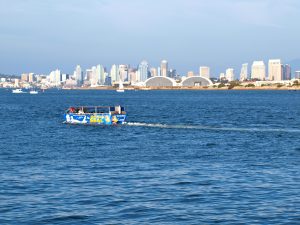
Environment. Shelter Island is one of the most popular spots on San Diego Bay. Resorts and restaurants share the island while the mile-long Shelter Island Shoreline Park spans the outside or bayside length of the island. Shoreline grassy areas, bike paths, picnic tables, play equipment, a public boat launch (the busiest in San Diego Bay), and the Shelter Island Pier share the park’s waterside venue.
On the inside, protected waters of the island are two harbor areas with several yacht clubs and and marinas along with associated businesses. The north harbor, now called Americas Cup Harbor, is not only home to an America Cup ship, but also home to San Diego’s various Sportfishing landings (H&M Landing, Fisherman’s Landing, Point Loma Sportfishing, etc.). Together they make up the world’s largest Sportfishing fleet.
Although we are most interested in the fishing, the pier (and nearby park) do provide great venues to view the bay and downtown buildings as well as to watch the watercraft, everything from kayaks to huge Navy ships and cruise ships.
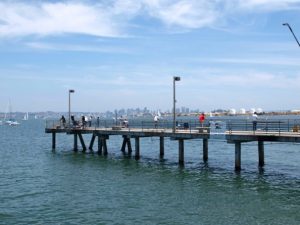
The pier itself is fairly new—and not the one that I fished in the ‘60s. That pier, the original Shelter Island Pier, was built in 1956 but condemned in 1990. A new pier, almost identical to the first, was built and opened in the summer of 1991. Surprisingly small for the number of fish caught, the pier extends out only about 200 feet from shore but has a T-shaped end that is nearly 500 feet in width.
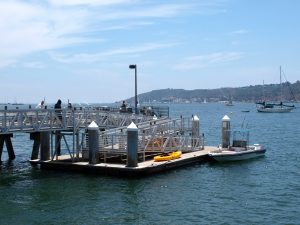
One major change is seen on the inside of the pier’s west wing where the city constructed a boat/kayak launch dock. The dock restricts casting inshore from that area of the pier. However, since fish like to hang under floating docks, nibbling away on attached organisms, it’s also an area that can produce a lot of fish. Just know that you are restricted as far as where you can fish (think straight down under the float).
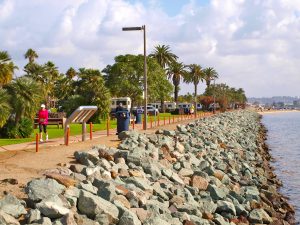
The bottom here is diverse. The shoreline itself is protected by riprap rock and some rocks are in the innermost areas. There is next a fairly narrow section of sand followed by a fairly extensive eelgrass bed that extends about two thirds of the distance of the pier. Past the eelgrass the bottom is mostly sand and mud. Casting out away from the pier yields deeper water and some obstructions but mostly it’s still sand and mud.
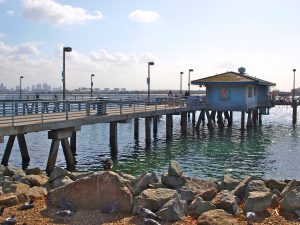
The pier itself and its pilings are concrete and though the pilings don’t have much in the way of the mussels and barnacles that are so attractive to fish, they are often covered with kelp and it can attract fish.
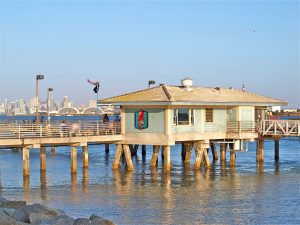
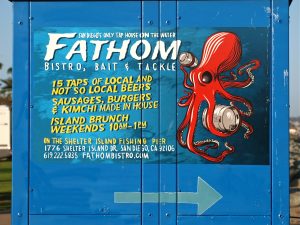
Fish. Typically anglers either fish the inside section of the pier between the pier and shoreline or cast out from the end. Inshore, both by the rocks themselves (high tide) and in the eelgrass, anglers can see bass (kelp bass, sand bass, and spotted bay bass), perch (blackperch and rubberlip), perch-like species (opaleye and halfmoon), and an occasional halibut.
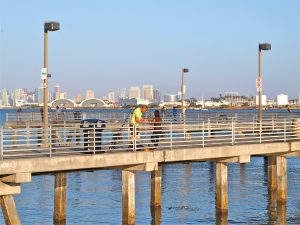
In the inside section, between the eelgrass and the pier (a mostly sand bottom), anglers will see some flatfish—halibut and turbot, as well as some croakers (yellowfin, spotfin and black), sargo, smelt and an occasional rock wrasse.
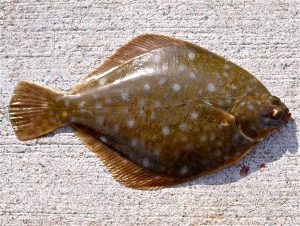
Diamond turbot
Casting out from the end can yield all of the already mentioned fish, but also presents more of the pelagic species. When fishing on the bottom anglers can expect the three species of bass, the three larger croakers mentioned above, the smaller croakers—queenfish (herring) and white croaker (tomcod), flatfish and quite a few scorpionfish (sculpin). If lucky, an angler might catch a sheephead. If unlucky, you might catch a lizardfish.
Anglers fishing the top water area may encounter Pacific mackerel, jack mackerel (sometimes), jacksmelt and, especially at night, barracuda.
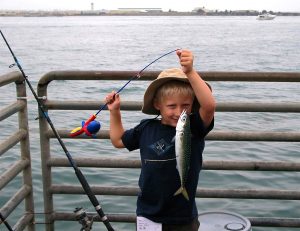
Pacific mackerel
As for the sharays (sharks and rays) the pier isn’t considered that good, with the exception of bat rays, but sharks are caught and some are good sized. Most common species are the aforementioned bat rays along with some sand sharks (gray smoothhound shark), shovelnose sharks (guitarfish), thornback rays and round stingrays.
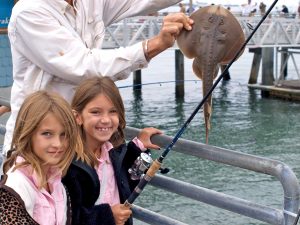
Thornback ray
High tide usually seems to be the best time to fish although some fish are around the pier at all hours. Do be warned that tides can at times produce a strong enough current to require a fairly heavy sinker. However, this is primarily true when casting out from the pier in deeper water.
Unusual catches at the pier have included several Pacific angel sharks (Squatina californica), thresher sharks, horn sharks, large butterfly rays, and a rare banded guitarfish (Zapteryx exasperata), a species that is usually found from Mexico to Panama but which occasionally is seen in San Diego Bay. The latter was reported to weigh 24 pounds but looked much smaller in the pictures. A 38” soupfin shark was landed in March of ’01.
Although more common in the south bay, a few Cortez bonefish have been caught at the pier. Shortfin corvina, a species that was once considered rare, started showing up regularly in reports in 2003 and seem to have increased in number; their numbers continue to mystify the experts. If you want to try for the corvina fish live bait (i.e., smelt) under a float or try a spoon at night.
Starting with a baby 10-pound fish reported in October of ’97, we have also had a number of giant (black) sea bass reported at the pier. Most have been properly released although some were misidentified and kept (including a seven pound, eleven ounce fish misidentified as a salmon grouper in April of ’08). Remember that they are illegal and must be returned to the water.
A common fish of uncommon size was reported in August of ’09 when a huge sculpin (scorpionfish) was caught from the pier, a fish supposedly measuring 24 inches in length. Since most books report the maximum size of the scorpionfish at 17” it would seem that either the fish identification or size was mistaken. However, given the always-unexpected nature of saltwater fish you just never know.
Another mid-identified fish was an 18-inch fish taken in July of 2011. It was reported as a spotted sole but there isn’t any such critter. There is a spotted turbot, Pleuronichthys ritteri, but it’s only reported to reach 11.5 inches long. In all likelihood it was a diamond turbot, a species that maxes out at 18 inches.
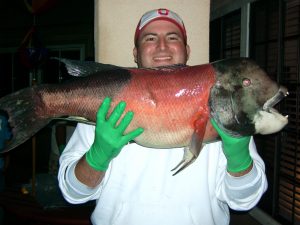
21-pound, 36-inch-long sheephead caught by Jesse Campbell at the pier on February 20, 2007. He caught the large fish using a long strip of squid for bait.
A somewhat unexpected prize during the past couple of decades has been sheephead. Many of the buck-toothed fish have been caught and quite a few were good-sized pier fish. A wayward 17” sheepie made a mistake in visiting the pier in April of ’00, two nearly identical 14-pound billygoats were caught in December of ‘2000, an 11-pounder was caught in January of ’01, and a twelve-pound humpy was caught in March of ’01. In February of 2002, in a two-week span alone, over eight sheephead were caught, several in the 16-18 pound range. A large 20-pound fish decided to take the bait in March 2005 but all of the previous goats were topped in size by a 21-pound, 36-inch sheephead taken by Jesse Campbell on a strip of squid in February of ‘07. Several large sheephead have been landed in the intervening years.
Why the number of sheephead given that when I first fished the pier in the ’60s sheephead were rarely if ever seen at the pier? The answer may due to an actual change in bottom conditions.
According to Halibut Bud (Bud Leavensworth), one of the pier’s regulars, a pipe was laid out from the pier and subsequently covered with rocks (approximately 100 yards out on the left end, 70 yards out on the right end). In essence, it was an artificial reef of sorts. According to Bud, after the reef was established the number of sheephead saw a substantial increase in numbers. It sounds similar to the “pipe-reef” at the Goleta Pier where a large pipe runs parallel to the side of the pier, it’s covered with rocks, and the reef is noted as a steady producer of rocky habitat species such as rockfish, bass, and sheephead.
By the way, the plethora of nicknames for the fish are many— sheephead, sheepie, bucktooth, goat, billygoat, snaggle tooth, humpy, fathead, and the simple red fish. That’s a lot of names for these black, red and white gamesters. And perhaps, given the colors, they should become a school mascot? There has been an attempt by some people to replace the mascot at my old school, San Diego State. They want something a little more politically correct than Aztecs or Montezuma. Since the school’s colors are black, red and white, I nominate a fighting fish—sheephead—as the new name for a mascot. But what sounds better, the San Diego State “Sheepheads,” “Sheepies,” “Billygoats,” “Snaggletooths.” or “Humpies?” After all, any of these would be a better name than that used at U.C. Santa Cruz, the “Banana slugs,“ the puny-sounding “Poets” of Whittier College, or even the “Fighting Pickles” of North Carolina School of the Arts. Perhaps we could take a poll and forward it on to the chancellor.)
Fishing Tips. As is true at most places, live bait is almost always the best bait and there was a time when live anchovies were available at the pier’s bait shop. Occasionally other live bait was also available but those days are over. Still, that doesn’t stop a person from netting his own live bait via an umbrella drop net. Using such a net a person can almost always gather a few anchovies and when available they can be used both on the bottom and on the top.
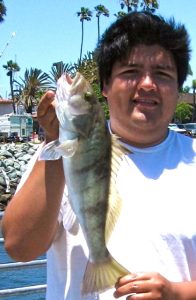
Barred sand bass
If seeking out halibut or bass (sand bass, kelp bass, and spotted bay bass) try casting out to the area between the eelgrass and the pier using a Carolina-type leader on the bottom with the live bait. The same bait and rig can also work when casting out from the end of the pier but the inshore area is a better area. If anchovies are unavailable, you can also try using smelt, shinerperch, small herring, tomcod or lizardfish that you have caught.
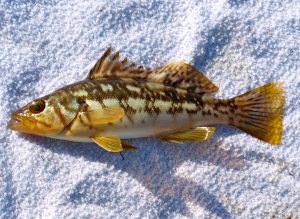
Kelp (calico) bass
Live bait, primarily anchovies can also be deadly on mackerel but fish the waters out from the pier (or straight down). The most common method is to simply tie a size 4 or 2 hook to the end of a line, weight it down with split-shot or a small twist-on sinker, cast it out and keep it near the top of the water, much like you would on a boat. Another approach is simply to tie a couple of size 6-2 hooks on to your line high/low style with a light torpedo sinker as weight. Cast out and retrieve slowly for the macs.
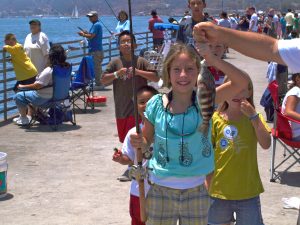
Spotted sand bass aka bay bass
The first approach seems to work best if the mackerel are being persnickety, the second approach works when they’re a little more gluttonous. If you do not have live bait try a cut piece of anchovy or sardine or, and it’s often the best bait of all, try a small piece of mackerel. Many people also use Sabiki-type bait rigs for the mackerel but I’ve never felt they worked as well here as at oceanfront piers.
If bonito show up, use live bait on a slider rig, a feather trailing behind a Cast-a-Bubble, or a lure like a MegaBait. Barracuda also occasionally put on a show, most often at night, and the key for them is to use live bait or a small lure like a Kastmaster, Krocodile (gold, silver, blue-chrome or green-chrome), or MegaBait. However, make sure you keep only legal-size fish.
For queenfish and white croaker, fish near the pilings but do not use a whole anchovy, use a strip of anchovy about two inches long.
Fishing in the same locations, but using a high/low leader and ghost shrimp, bloodworms, clams, or fresh mussels, will often yield spotfin croaker, yellowfin croaker, sargo, and a few black croaker, especially during the summer to fall months. It is my experience that more bass, halibut, and large croaker are caught on the left end to middle of the pier while more sharks and rays are taken on the right end of the pier.
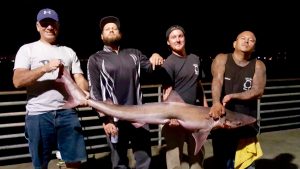
Soupfin shark
Like most piers, the best times for sharks and rays are at night. Bat rays exceeding 125 pounds in size have been landed here, as have some fairly large shovelnose guitarfish and leopard sharks. The shovels and leopards prefer a bloody piece of mackerel while the bat rays prefer squid. Another mostly nighttime visitor is scorpionfish and most of the scorps are landed on high/low leaders baited with strips of squid or cut anchovy.
During the winter and spring months blackperch and opaleye will inhabit the inshore area and the area under the pier, especially near the tackle shop. Use a couple of small size 6 or 8 hooks and bait up with sea worms, fresh mussels or ghost shrimp. Opaleye connoisseurs will try frozen peas or ghost shrimp for these large perch-like fish.
You may see a few needlefish swim around the pier and you may want to catch them. Be cautioned, the process can be exasperating. They like live bait best (such as a lively small smelt fished under a bobber) but are very hard to hook. Sometimes you can watch what they are doing but even so will be unable to hook them. But they can be fun.
Many anglers, including myself at times, get wrapped up in the world of rods, reels and assorted tackle. Then I remember what I observed during one visit to Shelter Island Pier. On that particular morning, fishing was only fair with a few mackerel and kelp bass filling the buckets. The bait shop was being rebuilt and live bait was unavailable.
Then a family of Vietnamese-Americans arrived. They dropped a net over the side and soon they had small smelt and anchovies swimming in their buckets. For tackle they had simple bamboo rods, about eight feet long, each equipped with a single guide at the tip of the rod. For reels they used spools of line. To cast they swung the rod with their right arm while holding the spool of line with their left hand. Casts were about as good as those by anglers using more expensive tackle. To reel in, they simply wound the line onto the spool much like a reel does. They quickly began to out-fish the other fishermen, at least until a few people began to borrow bait.
The key was the right bait; the tackle, as in many pier situations, was not as important. There are times and places where you need the best tackle you can buy. However, pier fishermen can often get by with the simplest of equipment and to me this is one of the beauties of pier fishing. It allows anyone, regardless of financial status, the chance to go fishing.
This was the only place where I saw such tackle used until a visit to the Monterey Wharf #2 a few years later. Using a similar rod and stationary spool, a frail looking, elderly Vietnamese-American angler was making tremendous casts out into the bay. Terminal tackle was a multi-hook leader on which he was hooking one to four jack mackerel (Spanish mackerel) nearly every cast, while most fishermen were going fishless.
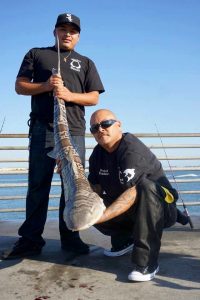
Leopard shark
Bass continue to be one of the most common fish taken at the pier, and all three local species are taken. My records show about 60% of the bass being sand bass, with calicos (kelp bass) registering about 30% and spotted (bay) bass representing about 10%. However, the mix depends on your bait and rigging. The sandies seem to like a variety of baits including anchovies, ghost shrimp, fresh mussel and even strips of squid, while the calicos seem to prefer fishy offerings—cut anchovies or mackerel as food. Both calicos and bay bass are attracted by artificial lures and more and more regulars are using them when the pier isn’t too crowded. Favorites include curly-tail lures like Berkley Swimming Mullets (pink), Big Hammers, Fish Traps, small Scampis and Scroungers (if you can find them). Best spots for the bass when using lures seems to be by the eelgrass; fish the edges of the grass or sandy spots you can see in the grass. Of course it’s harder to fish such spots at night but nighttime often seems to produce the largest spotties. I’m not really sure it helps but some people do add Strike Lites when they’re fishing at night.
Shelter Island Pier, like most piers, has its regulars, anglers who are on the pier on sunny days, June-gloom days, and even the few days that it rains in San Diego. One such regular was a fellow named Dan Hoar whose specialty was catching fish, especially sand bass. In February 1997 I received a report from Pier Master Buddy Hanks that Mr. Hoar had caught a 12-pound sand bass that was the biggest sandie that any of the regulars had ever seen (the state record was 13 lb. 3 oz.). Apparently there had been a run of bass with Mr. Hoar landing limits of the grumpies every day for over two weeks by using ghost shrimp and cut mackerel as bait. Watch the regulars and learn! The sand bass by the way seem most common from about November to March when they begin to leave the bay for their spawning grounds.
The days of the large sand bass seem to be pretty much over even if an occasional nice-sized fish is still caught. As mentioned previously the bottom has been changed with the pipe-reef and though conditions for the sheephead improved they seem to have adversely affected the number of large sand bass. However, a second reason may play a larger role. The rock pile seems to have become a favorite spot for boaters to target sand bass and that may offer a better reason for the decrease in numbers of the large sand bass.
Lastly, although the pier has never been noted for crabs, it does produce quite a few lobsters and most are taken at night in the eelgrass area of the pier. Bugs to nearly 11 pounds in weight have been landed.
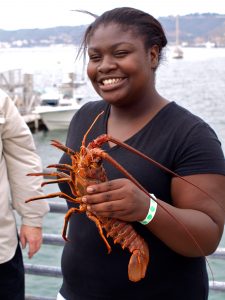
Lobsters are fairly common at the pier
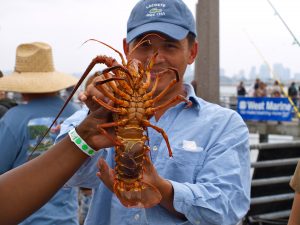
Potpourri — a mix of stories and and some pictures of those crazy old pelicans who hang out at the pier.
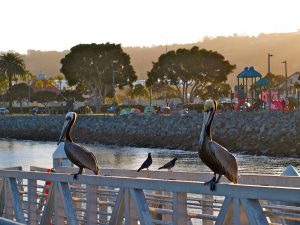
<*}}}}}}}}}>< — When I was young (quite a long, long time ago), I would often try for perch by the inshore rocks. By using small, size 8 hooks, I was able to occasionally latch on to a decent-sized perch. However, I also caught a lot of unusual little fish, none of which was a keeper in ANY sense of the word. There were a number of little sculpins and blennys that qualified for the “different and strange” category. One such sculpin, still unidentified, is seen below, a fish caught in October 2021.
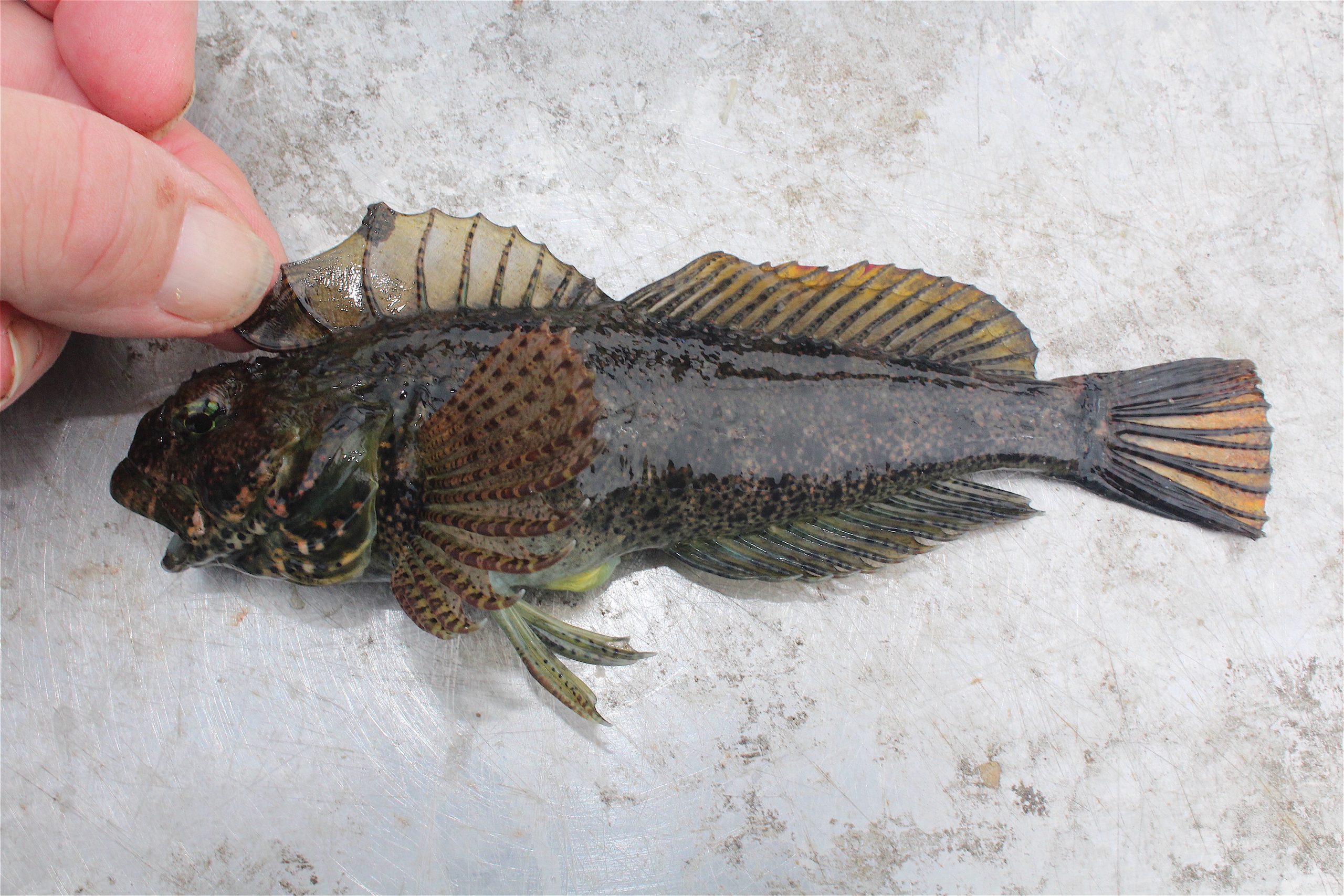
Most unusual were the sarcastic fringehead, tiny fish with a Napoleonic complex. I caught several of the fish, none of which reached 8 inches in length, yet every one of them seemed to want to attack my hand with his or her gargantuan-sized mouth. Sounds like fish on steroids, the ‘roids messing up their mind and making them just a tad bit crazy. It’s a good thing the fringies don’t reach a large size because they would probably terrorize the pier. I can see it now, up high on the light poles, a new set of warning signs: Danger, Vicious Sarcastic Fringehead, Handle With Care.
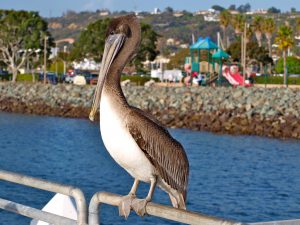
<*}}}}}}}}}>< — Fish surveys conducted by the California Department of Fish and Game from 2004-2009 reveal a fairly typical mix of species for a pier located in a SoCal bay. The list (numerically) — Pacific mackerel, shiner perch, Pacific bonito (all in one warm-water year), jacksmelt, black perch, northern anchovy, topsmelt, yellowfin croaker, California lizardfish, spotted sandbass, queenfish, barred sandbass, white seaperch, orangemouth corvina, California halibut, California scorpionfish, rubberlip saeperch, black croaker, white croaker, sargo, diamond turbot, California grunion, halfmoon and jack mackerel. Two problems that I see: (1) few of the surveys are ever done at night so sharks and rays tend not to be recorded and (2) the people taking the surveys do their best but often cannot identify unusual species. I would guess with near certainty that the fish identified as orangemouth corvina were actually shortfin corvina, a fish that has shown up in fairly decent numbers in San Diego Bay during the past decade.
<*}}}}}}}}}>< — Although the eelgrass found on the side of the pier is a very productive spot to fish, I do not remember it being so plentiful in the ‘60s-‘80s. I have heard that eelgrass has multiplied in the bay as water has been cleaned up, and I have heard that there was a growth in eelgrass following the El Niño storms of the ‘80s and ‘90s. Whatever the case, there is considerable eelgrass today. One interesting study I read concerned the number of small fish and crustaceans that live amidst the eelgrass (considerable numbers). One thing it mentioned that was the grass shrimp that live in the grass move around at a much greater rate at night supposedly because they are less susceptible to predadation by bigger fish. That fact may help explain why fishing for bass is often better at night in the eelgrass area—the shrimp are moving around as are the bass in response. It does tend to mean that the shrimp guessed wrong.
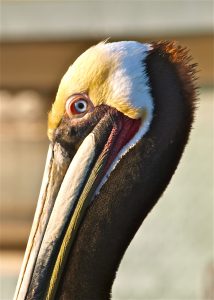
<*}}}}}}}}}>< — The first time I visited the pier after they added the floating dock for kayaks, I gave the area a good once over and immediately was struck by how fishy the area looked. There had to be fish under that float! However, that on that visit I was just taking pictures. Lo and behold I’m at the pier in July ’09 for the Kid’s Fishing Derby and the winner proved my thoughts to be correct. One of the youngsters, a regular at the pier who knew the pier, and what would work, caught 30 bass fishing the edge of that dock. The spot, and one added ingredient—live pinhead anchovies he gathered with a net, helped him out-fish the other contestants about 15-1. Unfortunately, almost all of the bass (three varieties) were small and under the legal size. But, the fish were indeed in that spot. Always try to think like a fish; if a spot looks really fishy, it probably really is.
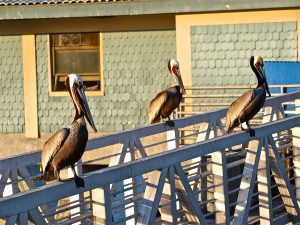
<*}}}}}}}}}>< — For a number of years in the early 2000s, a regular sight was to see a bow and arrow “fishing” from the pier in the inshore area. Mainly what he shot were halibut or other bottom fish and occasionally he would get some that were pretty good-sized. Eventually though the Port District became concerned that someone would get hurt and banned the practice both at Shelter Island and at other piers maintained by the district.
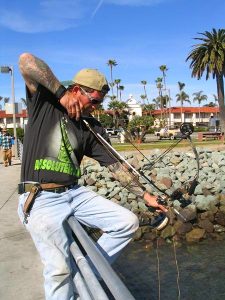
Pier Fishing In California Fish Reports
April 1997—Buddy Hakes at his Shelter Island Pier Bait & Tackle reports a good run of bonito has excited his anglers for the past week (including 30 the day of the report). The boneheads are falling for lures and live sardines (anchovies are still unavailable). Mackerel are also present; they are hitting strips of squid. Fishermen trying the bottom are connecting on sand bass and have started picking up a few more halibut—including two keepers this week. Most of the smaller schooling species are absent but a few anglers are still nabbing some perch and opaleye; most perch are hitting squid while the opaleye hit frozen peas.
June 1997—Buddy Hakes at his Shelter Island Pier Bait & Tackle reports a continued good run of bonito. In fact, he says it’s as good as he has seen it in his sixteen years at the pier. He also says they’re a nice size, averaging 2 1/2 to 3 pounds each. Lots of sand bass, a few calico bass (kelp bass), and halibut are also being caught. Most of the halibut are short but there are a few keepers every day and one angler landed a nice 32″ fish. Most fish are being caught on live anchovies. Mackerel are also abundant; they fall to live bait or strips of squid. Rounding out the action are yellowfin croaker (mostly caught on mussels) and white seabass (averaging 20” and thus illegal). At night, a few sharks and rays continue to fall to anglers using squid for bait.
April 1999—Jimmy, at the Shelter Island Pier Bait & Tackle Shop, says that bait is in the water and the fishing is picking up. Anglers are getting lots of 12-15” mackerel, some sand bass, and many buttermouth perch under the pier. The buttermouth are hitting on ghost shrimp and, surprisingly, squid. A few halibut have also been landed recently including a 29”/12-lb. beauty. One surprise was a 10 1/2 pound lobster that invaded an anglers trap.
May 2000—John, at the Shelter Island Pier Bait & Tackle Shop, says that things have started to pick up (finally). Lots of halibut have been showing lately as have bass (both sand bass and calicos—kelp bass). Mixed in are quite a few corbina, bat rays and round stingrays. Although many of the halibut are sub-legal size, several 23-24” fish have been landed on live bait. Ghost shrimp and anchovies have been the bait for most of the corbina with squid beings tops for the bat rays. Most unusual catch recently was a wayward 17” sheephead that made the mistake of visiting the pier; its picture is now on the wall for all to see.
March 2002—John, at the Shelter Island Pier Bait & Tackle Shop, says that the fishing is still fairly slow although a variety of fish are being taken: sand bass, buttermouth perch (blackperch), and an increasing number of mackerel. At least 8 sheephead have also been landed in the last couple of weeks, several in the 16-18 pound range. The best bait for the sheepies has been market shrimp or ghost shrimp.
December 2003—Miguel, at the Shelter Island Pier Bait & Tackle Shop, says that there are a lot of mackerel and once in a while a few bonito. Try pieces of squid or mackerel for the mackerel, bubbles and flies for the boneheads. There’s also a decent barracuda bite but it’s all early morning when the birds are working the action; it’s over by 8 a.m. For the barries use Krocodiles. He’s also seeing a few sand bass on the bottom but not much else.
May 2004—Miguel, at the Shelter Island Pier Bait & Tackle Shop, says that there has been a good run of barracuda at the pier with most of the 20-25 inch fish hitting on Krocodiles or MegaBaits. He says they are hitting both in the day and at night and the only thing that stops them is when the sea lions show up. He’s also seeing some sand bass, yellowfin croaker, corvina, buttermouth perch (black perch) and splittail perch (white perch). Mackerel are showing in increasing numbers.
November 2004—Miguel, at the Shelter Island Pier Bait & Tackle Shop, says the bonito action remains strong with a variety of devices catching them—Rapalas, MegaBaits, Krocodiles and Cast-A-Bubbles with feathers. A few mackerel are showing up as well as some sand bass on the bottom. The bass are hitting on ghost shrimp and cut anchovies. Some halibut, mostly shorts, are hitting on live smelt while bat rays and lobsters are showing at night. Some shortfin corvina are also being taken, most generally in the early morning on Rapalas.
June 2005—Miguel, at the Shelter Island Pier Bait & Tackle Shop, says things are o.k. if you know what you are doing. There was pretty good action on mackerel and barracuda until the water temperature dropped last week; since then the bite has slowed. (The barracuda were mostly 18-26 inches although some legal fish were also taken. Miguel said he got 11 barries one day using a 3/4 oz. Mega Bait.) He says about 2-3 legal halibut are showing per day on live shinerperch, anchovies, or sardines (the latter two available at the pier). A few corvina, sand bass and big jacksmelt round out the action.
September 2005—Christine, at the Shelter Island Pier Bait & Tackle Shop, says mackerel is the main action together with sand bass, queenfish and lizardfish. A few halibut and opaleye have also been landed as well as mullet. The decent-sized mullet are being captured by people using lettuce or peas although a few people are also trying to snag them. The ones that have reached the pier’s surface have all weighed about 4 pounds and up.
June 2006—Miguel, at the Shelter Island Pier Bait & Tackle Shop, says anglers are getting lots of mackerel on top along with some sand bass on the bottom. He’s been getting good numbers oh halibut on 4-pound test line with a small trout pole (says they just will not hit heavier line). His fish have ranged from 18-25” and most of the fish have hit on Storm Finess Minnows w/anchovy color. A few shortfin corvina are also being landed, most by people using live smelt as bait.
November 2007—Ed, at Sharkey’s B&T, says there’s still a good variety of fish. It’s mainly mackerel on top along with a few bonito. The bottom is yielding up a variety of bass—sand, calico and spotted, most to cut bait. Some halibut are showing but almost all are sub-legal fish. A few shortfin corvina are also showing, usually at night, and they hit live bait. Opaleye are available inshore to those using ghost shrimp.
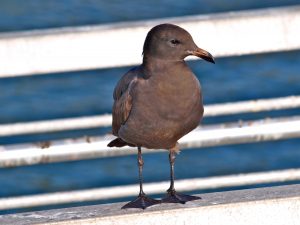
San Diego IGFA Young Anglers Tournament —Young Anglers’ Fishing Tournament
Shelter Island Pier—2005
On Saturday, July 23rd over 70 young anglers and their families turned out at Shelter Island Pier to compete in the IGFA Young Angler Pier Tournament Series. Anglers were invited to use their own gear or use rod & reel combos provided by Okuma Fishing Tackle. Tournament winners in each age group were determined by the number of fish and species caught. The catch included bass, mackerel, halibut and queen fish. In most cases, all of our contestants practiced “catch and release.” Age group winners received fishing trips from Pt. Loma Sportfishing’s and H & M Landing’s 1⁄2 day boats, the Daily Double and the Fisherman III. Other prizes included Gift Certificates from Shelter Island Pier Concession, Target, and Wal Mart. The older aged group winners received merchandise from West Marine and Boaters World… Listed below are our tournament age group winners. The tournament’s “Top Angler” was a tie between Bobby Atkins, 12 yrs. and Cody Clark, 14 yrs., each with 95 points. Each was presented with a new rod & reel combo’s from Okuma Fishing Tackle and their names will be engraved on the Shelter Island Perpetual Trophy by artist David Wirth.
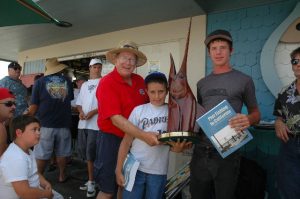
Name, Age, City, Pts: Kekoa Fernandez 6 SD 35; Vincent Khounborin 7 SD 55; Ryan Kyle 8 SD 60; Andrew Gutierrez 9 Poway 20; D.J. Evans 10 SD 20; Tory Jackson 11 SD 55; Bobby Atkins 12 SD 95; Dante Breeding 13 SD 5; Guillermo Cardenas 13 Chula Vista 5; Cody Clark 14 Las Vegas, NV 95; Anita Byra 15 SD 55…The series is sponsored by the IGFA and the San Diego Sportfishing Council with support from the San Diego Port District and UPSAC (United Pier and Shore Anglers of California).
—Posted by Baitfish, July 23, 2005
Youth tourney angling for anglers of future
Shelter Island Pier—2006
The hope is that they will grow up and be fishermen, that they will take up the sport and become the future of an industry that is always looking for a few good anglers.
That’s the hope and part of the thinking that drives the Young Anglers Tournament at Shelter Island Pier each year, and yesterday was the fourth year in a row that the T-shaped pier was wedged with kids 15 and under. Organizer Catherine Miller of the San Diego Sportfishing Council said there were more than 110 kids on the pier competing for prizes, enjoying the free day.
Sponsored by the San Diego Sportfishing Council and the International Game Fish Association, the tournament draws kids as well as a slew of volunteers from the pier’s concession, the San Diego Rod and Reel Club, and, most helpful of all, the pier rats from United Pier and Shore Anglers of California.
Miguel Mestre, pier manager, and his girlfriend Christine Guaglianone turned the pier over to the kids, with Guaglianone going so far as to chum the area with chopped bait to get the fish stirred up for the kids.
Kids practice catch-and-release and fish for points to win prizes in their respective age divisions. They received 5 points for halibut and barracuda; 3 points for bass, corbina or croaker; 2 points for mackerel; and 1 for any other fish. The overall winner is invited to Florida the following summer to fish in the IGFA’s junior championship.
There was a three-way tie for the overall winner this year: last year’s champion Thomas Orozco, 6, of Union City (near San Francisco); Gabriel Villaverde, 14, of Chula Vista; and Dominick Vergili, 11, of San Diego. They received a slew of prizes and will get their names on the perpetual trophy done by wood sculptor David Wirth.
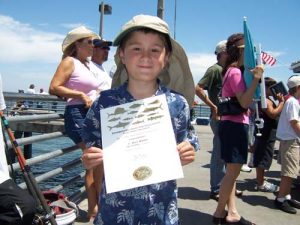
Thomas Orozco
Orozco acts the part of a seasoned angler, and he should. He qualified at Pepper Park Pier in National City last year for the 2006 Mercury/IGFA Junior Angler World Championship in Florida. He competed in June and finished sixth in his Small Fry class that included 39 youngsters.
“One day he caught 40 fish,” said Thomas’ proud dad, Gilbert, a real estate broker who said business is good enough to allow him to shuttle himself and son from the Bay Area to faraway places like Key West, Fla., and San Diego for junior fishing tournaments.
Miller has worked each tournament with co-founder John Campbell, who, like Miller, is an International Game Fish Association representative. “I originally started this at Shelter Island as a way to get the pier some attention,” Campbell said. “We’re very happy with the growth of the tournament. This was the largest group we’ve ever had for a pier event.”
Aaron Meaux, 10, visiting from Tulsa, Okla., was believed to have caught the first fish yesterday, a sand bass. He was fishing with his cousins Hunter Lee, 11, and Harrison Lee, 4, and Savannah Benes, 12. Jean Rockwell and Jonathan Lee and Rick Benes watched their youngsters have a good time on the pier.
“This is a great way to introduce kids to fishing,” Rockwell said, and Jonathan Lee said the tournament was well-organized and -run.
Brandon Bay, 7, couldn’t wait to get to the pier. “He really loves to fish, so when we saw they were having this we decided to check it out,” Dan Bay said. “He caught an undersized halibut earlier, ate a hot dog and had some lemonade. It was well worthwhile coming down.”
There was a generous raffle, and each division winner took home a bag of goodies from the event’s many sponsors, including half-and three-quarter-day trips from Point Loma Sportfishing and H&M Landing. Bay won the 7-year-old class, and other winners included: Sam Guest, 8; Leonardo Sanchez, 9; Rafael Baca, 10; Sabrina O’Neal (the 2003 champion), 12; Chuck Byron IV, 13; and Anthony Tran, the best 15-year-old angler.
Miller, who worked summers on the Shelter Island Pier as a teen, praised the work of the many volunteers, such as Bill Reimund of Quail Unlimited and the San Diego Chapter of the National Wild Turkey Federation; Tom Withers, who shot photos and assisted Miller; Tom Gruber and his daughter, Kathy Brake; Lori Byron and Dave Sachau of the San Diego Rod and Reel Club; and Joe Bain, representing Chollas Lake. There were nine pier rats in all from UPSAC – Adam and Rebecca Cassidy, Rod Mina, Jon Vilchez, Jon Almon, Steve and Marie Scialpi, Chris Amos and Mark Catton. “We couldn’t do it without these guys (pier rats),” said Miller.
Volunteers stretched along the pier helping kids cut bait, bait hooks, cast and anything else the kids needed. The young anglers learned valuable lessons, including how to get along with each other on a crowded pier.
A variety of ethnicities and cultures were represented, but the folks found one common denominator, fishing. “Many of the captains and deckhands in our fleet started working or fishing on piers,” Miller said. “It’s important for us to get kids fishing.”
—By Ed Zieralski, Outdoors, San Diego Union-Tribune, July 16, 2006
Results of the Fifth Annual IGFA Young Anglers Tournament
Shelter Island Pier—2007
Over at Shelter Island Pier yesterday, 70 young anglers ages 6 to 15 competed in the points tournament (all fish released) sponsored by the San Diego Sportfishing Council and the International Game Fish Association. Serena Jones took first place in the 6-year-old category. She’s the granddaughter of Ken Jones, author of the pier fisherman’s bible, “Pier Fishing In California.”
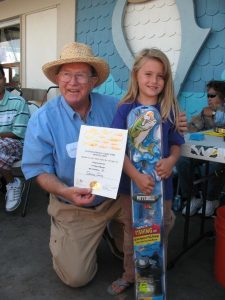
My granddaughter Serena Jones
Other age-class winners included Andrew Espirito, 7; Abraham Alvarez, 8; Amanda Byra, 9; Jessica Hernandez, 10; Jake Kertzman, 11; Conner Ballantyne, 12; Sabrina O’Neal, 13; Sierra Spinuzza and Jordan Moore, 14, tied; Justin Lee, 15.
Sabrina O’Neal was the overall points winner with 18 and won for the second time in the tournament’s history. She also won in 2004. Her name will be engraved in the Young Angler Tournament perpetual trophy, which will be on display at the Shelter Island pier.
Over $1,500 in prizes were distributed among the winners and each was presented with an IGFA certificate. Prizes and raffle drawing items for the tournament included rods and reels, hats, T-shirts, and fishing gear.
Other event sponsors include the Port of San Diego and United Pier and Shore Anglers of California.
—Ed Zieralski, Outdoors, San Diego Union-Tribune, September 29, 2007
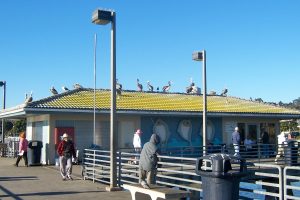
Obituary — William Clement (Bud) Hakes
<*}}}}}}}}}>< — For many years I had the pleasure of having a monthly conversation with Buddy Hakes when I would call down to the pier for the monthly report. Buddy was always friendly and frequently had a tall tale or two to tell. The bait and tackle shop he ran was one of the best in the area and a source of bait and tackle for me whenever I would visit San Diego. The store was also, more than once, a source of food since I love sausages and his specialty was the “Buddy Dog”—“six inches of pure heaven” according to his signs and T-shirts. “Rest in Peace” my friend.
Obituary — William Clement (Bud) Hakes: December 26, 1928 — November 18, 2003. The waterfront was his world, fishermen and tourists were his audience and hot dogs were his claim to fame.
But all Bud Hakes really cared about was his family. William Clement “Bud” Hakes, lifetime resident of Coronado, died November 18 at 73 following a long battle with cancer. Bud, as his family and friends called him, hailed from one of Coronado’s oldest families… He graduated from Coronado High School in 1947 and shortly thereafter married his childhood sweetheart, Joanne Martinis, a graduate of Mercy College of Nursing, 1948…
In 1981 Bud discovered one of his greatest joys was the work he took on after retirement when he and wife Joanne opened a food and fishing pier concession at South Embarcadero Park. The Port of San Diego was so impressed with the Hakes’ work they asked them to take over the Shelter Island pier concession, which they did the following year. In 1983 they expanded again with the Chula Vista fishing pier. In 1985, with the cruise ship industry booming, they took over the gift shop in the Cruise Ship Terminal at the foot of B Street, Downtown San Diego.
The trademark menu item at the tiny food outlets was the Buddi-Dog, a delicious hot dog still served up at various locations along the bay. Many a fisherman, boater and waterfront writer paused to enjoy one of the famous Hakes’ Buddi-Dogs over the years, tender hot dogs shrouded in a variety of condiments that enticed you to buy them by the handful.
Of course, a chance to sit for a minute or two and talk with Bud Hakes was worth the price of a hundred hot dogs. He knew all the fishermen, their bait, their personal best and usually the names of their wives and children. He could wax fluently on the weather, the tide, politics or the horses running at Del Mar. He loved the horses.
From 1981 until 2002 Bud, alongside his wife and grown children, worked daily at the fishing piers in Chula Vista, Shelter Island and Embarcadero South, as well as in the Cruise Ship Terminal on Tuesdays. “Bud loved the fishermen and the tourists,’ said Joanne. “He had a great wit, and was a wonderful PR man for the Port of San Diego. To help him remember names, he devised nicknames for the many people he met on the piers. Everyone loved Bud.” In 2002, Bud was forced to retire again, this time due to illness.
Coronado Eagle & Journal, December 1, 2003
The Pier Rats Speak — Selected posts from the Pier Fishing In California Message Board
Date: November 24, 1998; To: Pier Fishing In California Message Board; From: JW ; Subject: Shelter Island
In reply to “Could use some surf fishing info posted by Dave McDowell.” … I have witnessed a guy that we call the “Opaleye guy” at Shelter Island Pier. He usually fishes right in front of the little retail shop on that pier with frozen peas and ghost shrimp. In all the times I have been there, I have never seen this guy leave with less than four or five Opaleye.
Date: December 23, 1999; To: PFIC Message Board; From: jettyman; Subject: Shelter Island Report
I was out at Shelter Island Pier today from 2:00-5:00 P:M. It was really windy, which made casting a little difficult. As it turned out I didn’t have to cast very far. Just dragging and dropping a Carolina rigged piece of frozen anchovy right under the dock gave me my first red sculpin. I saw one other fisherman catch and release a skate, and I caught a few needlefish but that was about it. The sunsets over there are something. Tight lines to all and to all a good night! Jettyman
Date: May 30, 2001; To: PFIC Message Board; From: ben; Subject: Shelter Island Pier
I went fishing Sunday 5/27, fished from 2pm till 6:30pm. Bait: live anchovies. Location: next to the floating lifesaver. Rig: 1/4 oz. weight (stationary) two feet above a size 1 live bait hook. Catch: one-19” hali, another 16″ short hali, a legal looking hali which spit hook (DA*$@%T), another short spitter, two farmed bites, and a 14″ spotted sand bass. All in all it was a good day. The lady next to me was using a 1/8 ounce split shot and a size 4 baitholder hook with the same live anchovies with 4# test and was hooking ‘em left and right. All in all I’d say she caught about 10 halis by herself. She kept only one; most were undersized but it looked fun as heck to fight it on light line.
Date: March 29, 2004; To: PFIC Message Board; From: ophir; Subject: Shelter Island Pier 3/26 & 3/28
Decided to hit the pier on Friday to toss some Big Hammers, hoping to get in on the barracuda bite. Got to the pier around noon and couldn’t scrounge a bite until about 1pm, then they came in droves. Managed to land four and had them chasing my lure on every cast. No keepers — biggest was about 24.” Great time, but got most of my lures trashed by their big, sharp teeth. Guy next to me kept getting short hits and chased lures, but no hookups. Went back Sunday, hoping to get a little more of the fun ride, which is a barracuda. Got one around noon then missed a whole lotta bites and ended up with a bunch of tail-less 4” swimbaits. I switched to a smaller size and got nailed by the biggest mackerel I’ve seen. I got it to the surface and had to hand line it in; it was big, probably like 20″-22.” Unfortunately, it shook off when I was handlining, so I can’t claim landing it. It fought like hell on the 6-lb setup. A couple of guys next to me fishing blue/silver spoons were nailing the barracudas, but they were using such heavy gear they would just drag ’em across the surface. Kinda looks like they took all the fun out of it. One of the fish was legal, though. Looks like small and blue is the ticket. Gear: 6lb Maxima u/g & 8lb P-line CXX Clear, 7ft spinning, 4″ Big Hammers w/ 3/4oz 3/0 silver jig heads or 3″ BH w/ 1/2oz 2/0 silver jig heads, anything with blue and silver in it was hot.
Posted by baitfish
Try Blue and Chrome Krocodiles and Kastmasters. They are great for Barries and they don’t get torn up like plastics.
Posted by frozendog
Barracuda are a biological invention of the swimbait companies to make more money. Barracuda have been programmed to bite the tails off of expensive lures by the swimbait companies so fisherman will have to buy more. Maybe the barracuda get a bounty for each bitten off tail they turn in. Think about it!
Date: March 31, 2004; To: PFIC Message Board; From: mobilesuit; Subject: Shelter Island Pier
Thought that I would hit up Shelter Island Pier with all this talk about barracudas being there. Sure enough they were. Got to the pier around 11:30 am and started tossing 5/8 oz. blue mack Krocs with my friend. Around 12:00, hooked up on the first cuda about 24 inches long then around 12:30, hooked up on one that was 1/2″ short — 27.5.”
Moments later I hooked into another one that was again 27.5″ and about 15 mins. later, hooked into another that was about 24.” My friend also got hit but bit off. Thanks for the heads up about the cudas! It was a blast. Lots of quality fish! All were caught on the rise about 2 or 3 feet from the surface… no problems landing them on 8lb test.
Date: June 11, 2006; To: PFIC Message Board; From: west coast dave; Subject: Shelter Island Pier 6-7-06
I went back to Shelter Island on Wednesday. The pier was crowded, but the mackerel were not boiling. But they were still there. I used a bait catcher rig with pieces of squid and on my daughter’s rod a split-shot and hook setup with squid. My daughter immediately caught two Pacific mackerel and one jack mackerel. I was so busy helping her out with the fish, that I had not been able to start fishing me. The mackerel were the very first fish she ever caught. I took plenty of photos. I was a proud father. I later ended up catching 15 Mackerel myself. I also saw a couple of anglers catch and release some calico bass on plastics off the mid pier area. Tight Lines, Dave
Date: August 6, 2007; To: PFIC Message Board; From: ryanhead; Subject: Shelter Island Pier 8-5-07
I was down in SD for a weekend trip with the family and managed to get away Sunday morning for some fishing. I had never even seen Shelter Island Pier but had heard great things about it from this board and various other places online. It wasn’t quite what I expected, but it was still a nice pier. Unfortunately it was packed shoulder to shoulder up and down the pier the entire time we fished, from 11am until 4pm. Right when we got there a gentlemen was walking off with two yellowtails about 10 pounds each. I figured he must have got them on a boat but looking around, there was no boat. I’m still reluctant to believe that he caught them off the pier, but I can’t imagine where else they could have come from. In any case, the morning was hot, windy and miserably slow. A few sand bass came up and one small ray. Around 3pm boils erupted all around the pier, which produced a wide open mackerel bite. I threw a crippled herring out but nothing big wanted to play. People caught buckets of mackerel but nothing else. I got a few fly-lining anchovies. It was a fun pier, but I came with my expectations a little too high. I’d love to go back though. I noticed that the guys who were catching bass during the slow part of the day were casting about 30-50 yards off the right corner of the pier. It seemed to make a huge difference as no one else could even manage a bite. They used all sorts of bait too: squid, smelt, anchovies, mackerel pieces, and all sorts of rigs: Carolina, hi-lo, dropper loop.
Date: October 10, 2013; To: PFIC Message Board; From: Ken Jones; Subject: Shelter Island Pier 10/10/13
Shelter Island Pier — 8-11 — Many, many sub-legal size kelp bass, one nice-sized rock wrasse, two lizardfish and a topsmelt (all returned to the water). Only saw one other fish caught from the pier (and only about 6-8 anglers). The other fish that was caught was a halibut about 14-15 inches long. It was caught by a guy, in his 20s I am guessing, dressed nicely, with expensive rods and reels. I thought he was going to throw the halibut back but I see him put it in his knapsack. I walked over and said, “you know that’s an illegal fish.” His reply was “they never check here.” I then said that (1) I have seen fish and wildlife wardens check anglers at the pier and (2) it doesn’t matter if they do check, it’s an illegal fish and the right thing to do is put it back. Tell him the whole spiel about if we take the small, illegal fish they don’t become adults and then that cuts down the spawning which means less and less fish. He doesn’t reply but also doesn’t put the fish back. I go back to my spot, pick up my cell phone and make like I am calling CalTip. He proceeds to take the bag to his car before returning to fish some more. Poaching has been a problem we’ve talked about since this site started in ’97 and I just don’t see it getting better.
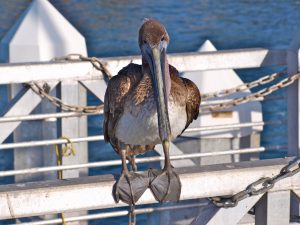
History Note. Shelter Island is basically a man-made area. Originally this was a submerged shoal located just offshore of the Point Loma Peninsula. It was listed as a “mudbank” and apparently was formed from soil deposited by the San Diego River. When the city and the U.S. Navy began to dredge San Diego Bay in the ’30s and ’40s, it dumped the excess mud onto the shoal. Eventually an island was created and in 1950 a causeway was built out to the island that allowed its development.
Today it is one of the most popular sites in the bay and one of the leading yacht centers on the West Coast. It hosted the America’s Cup Yacht races in 1988, 1992, and 1995 and, for a mere $100, you can take a ride in one of the America’s Cup Yachts (“Conner’s Americas Cup Experience”).
Another pier, much longer in size, once existed a little distance upshore from this area. It was known as the Roseville Wharf in the late 1880s, and provided a home base for several small boats, the most convenient and reliable transportation between Point Loma and San Diego in those days.
Shelter Island Pier Facts
Hours: The pier is open 24 hours a day although signs in the parking lot say no parking 10:30PM till 6AM. Fishermen who want to fish all night have not been bothered.
Facilities: Restrooms are at the foot of the pier as is free parking. Fish-cleaning stations and lights are on the pier. Sharkey’s Bait and Tackle shop is located on the pier. There’s also a small playground for children onshore, just south of the restrooms.
Handicapped Facilities: Although there are parking spaces for the handicapped, restrooms are not equipped for the handicapped. The pier surface is concrete and the rail height is 42 inches. Posted for handicapped.
Location: X33.654959222951774 N. Latitude, 118.004150390625 W. Longitude
How To Get There: Take I-5 or I-8 to Rosecrans (Hwy.209) and go west, turn left at Shelter Island Dr. and follow the road until you see the pier and the entrance to the parking lot.
Management: San Diego Unified Port District.
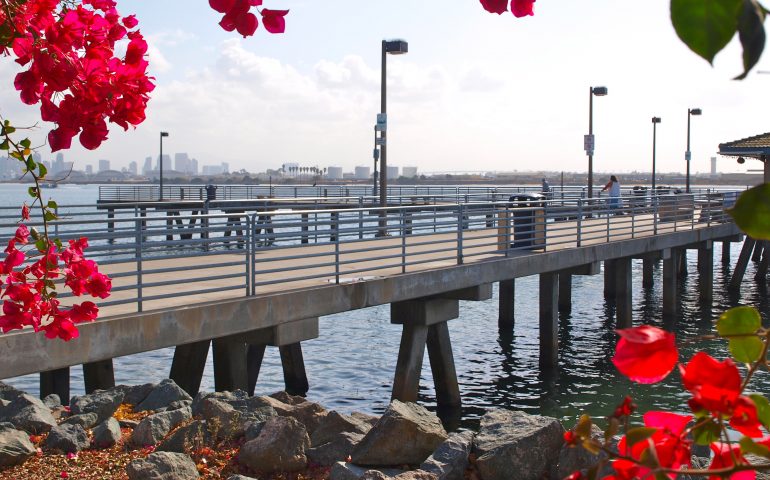
I remeber back in the 70s a grupe of guys fished the pier for Lobster they did good at one end of the pier was a life ring box they rote there catch on it the biggest one was 13 1/2 lb lobster it was green thing was huge sure miss fishing the pier had lot of fun
Just wanted to do an update to this page as this is a great pier to go fishing. I live in San Diego and this is our go to location. Convenient, great views and during the summer, fishing is great. Mackerel is usually the catch of the day. Easy to catch and has a nice little fight to them. Not the best eats but lots of fun to hook. I especially love this place for the views. You have the best look of the downtown skyline, Navy ships, seals and dolphins. We usually get to the pier right before sunrise. Mackerel is best right after the sun comes up as the fish are looking for breakfast. Ha! Parking is plentiful and convenient. Lots of regulars that will always share a smile, bait and fishing tips. This place is great for the first time and veteran angler.
Is there somewhere to rent poles and other stuff?
[…] Its calmer waters suit younger anglers. Target spotties, croaker, mackerel, and smaller halibut. Shelter Island Pier in San […]
I found 1win game after seeing someone post a screenshot of their slot win on a local forum. I was intrigued and decided to check it out. The slot section is really broad—some games have basic features, others come with wild symbols and bonus rounds. I liked how user-friendly the interface was, especially for someone new to casino apps. From India, the deposit methods worked fine too.